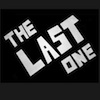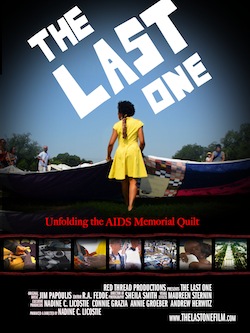 |
Stigma isn’t silent. It is loud. It is insidious. It is powerful. Whether spoken at the pulpit or spoken under breath, in political rhetoric or private conversation. In the documentary The Last One: The Story of the AIDS Memorial Quilt, we are following the Quilt from inception to the present day and we are looking for answers.
How did stigma and discrimination fuel the growth of an epidemic? Why did government fail to respond? How does health care and politics intersect in public health issues? And how did a community art project change perceptions, change the dialogue and change the way our country reacts to HIV/AIDS?
Watch the trailer and click here to help support the film:
Our journey began in 2011, as we became involved with The NAMES Project Foundation, which is the custodian of the Quilt, and their display at the Smithsonian Folklife Festival. As we helped to cull 25 years of memory, photographs and story, we quickly realized that this material needed to be documented immediately. The history of a people cannot be left to anecdote, it must be entered into the public record and made available to future generations. A documentary on the AIDS Memorial Quilt, we believed, would preserve the stories and keep them alive in digital form.
What we soon learned from looking back is just how present HIV/AIDS is today in the lives of those who lost loved ones and those who continue to suffer today from the impact of this disease. HIV/AIDS is not a story of yesterday. It is a story lived everyday here in the United States and throughout the world. The relevancy of the Quilt continues in 2014 as it did in 1987. We embarked on a path that would lead us across the country into communities of color, women advocacy organizations, LGBT centers, and AIDS service organizations to document the current impact of the disease on the millions of people affected by it.
At the center of our cinematic storytelling is a panel that was delivered in 1987. It includes a handwritten statement: “When the last one is named we will begin to heal.” The letters sewn onto it, spell out the words, “The Last One.” When the caretakers of the Quilt received this panel they knew just what to do: hold on to it and the hope it conveyed until it could be sewn into the Quilt.
Twenty-seven years after it was submitted, “The Last One” cannot be sewn into the Quilt. And as a documentarian it was paramount to me to find out why. What is happening today in health care, in society, in the media, and in the world of government and politics to help the HIV/AIDS community? Who are the people today, advocating for services, fighting discrimination, speaking out, and warning the world once again that stigma is an enemy of the people?
We found so many stories on our journey. We filmed some of these stories and wove them together into a film that I hope will start a new conversation and ignite the passion of a new generation of leaders, scientists, politicians, and educators to fight against the insidiousness of stigma and discrimination.
 |
We looked back to the early 1980s, when the medical community was unable to identify either its cause or a reliable treatment, and headlines proliferated on “the gay disease,” alongside speculation that it spread through casual contact. Adding this theory to the popular belief that gay people lead “deviant, abhorrent lifestyles” created all too fertile ground for discrimination and hate-mongering, in turn making AIDS a political anathema.
In response, the gay community raised their voices through civil disobedience and political action. Activist Cleve Jones envisioned organizing his community’s grief and anger to include a broader audience. He recalls the night when he asked a crowd of marchers to write down the names of those lost, plastering them on the façade of the Federal Building in San Francisco. There he sees a pattern in the patchwork of names, remembering the quilt his great-grandmother had made for him out of his great grandfather’s old pajamas. Unlikely fabrics stitched together. Remembrance. Warmth. Comfort. Love. And the AIDS Memorial Quilt was born.
Panel by panel, family, friends, activists, quilters, and churchgoers made quilts to express their fear, love, and passion, their politics and their grief. To this day, the panels follow a simple form: cloth cut into the size of a standard coffin, with the name of the deceased included in some way. They are sewn together into 12-foot by 12-foot blocks, and then at each display, as the cloth is unfurled, the names of the dead are read aloud for hours. The Quilt, along with other activist efforts, eventually forced the country to acknowledge the need for action.
The Last One highlights how the Quilt has transformed over time to serve a new generation living with HIV/AIDS, focusing in particular on the role stigma and discrimination play in an epidemic that too many people believe is under control in the United States, even as new infections continue at the rate of 50,000 annually.
Our film, like the Quilt and the work of activists around the globe, is a beacon of hope in not only the fight to end AIDS but also to end discrimination of all kinds. If we can look at each other through a common lens and see our common humanity, then maybe we can gather our forces and fight the common enemy. At the center of our discussion is a simple fact articulated by Cleve Jones: homophobia kills—and it doesn’t just kill gay people.
AIDS still threatens nearly every sector of society, but science now articulates a new narrative: if we test and treat enough people globally, the trajectory of the epidemic will shift. It is finally realistic to imagine a day when the NAMES Project can sew “The Last One” panel into the Quilt, representing the last new infection, the last AIDS case, the last child orphaned, and the last AIDS death.
Will it also be the last time stigma manifests into a pandemic?
Nadine C. Licostie is the director of The Last One: Unfolding the AIDS Memorial Quilt. Nadine’s range of experience in the film and television industry spans nearly 20 years and a variety of disciplines. With a passion for theatre, film, television and digital media, she has produced projects with some of the top talent in television, film and theatre.
As a director, Nadine is focused on creating stories that resonate politically and socially while also attaining entertainment value. Film and television projects include The Good Mother of Abangoh (documentary), The Best of the GLAAD Media Awards (MTV Networks) and Cyndi Lauper’s True Colors Fund (PSA Campaign). She is one of the principals of Red Thread Productions.
To contribute to the Kickstarter campaign to support the production costs of this film, click here.







1 Comment
1 Comment